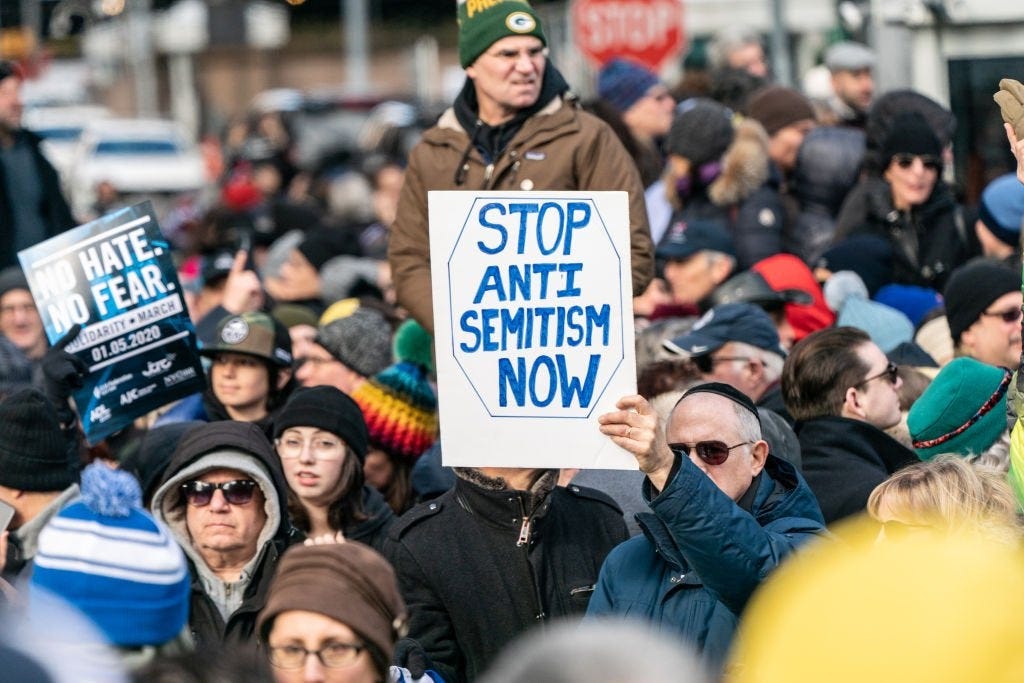
“Yesterday on our show, I misspoke,” Whoopi Goldberg announced on The View. “I said something that I feel a responsibility for not leaving unexamined, because my words upset so many people, which was never my intention.”
As is by now widely known, this apology came after the comedian and actor argued with her co-hosts that the Nazis and Jews were “two white groups of people” and therefore the Holocaust was “not about race.” On the Stephen Colbert show, she claimed “you can’t call this racism” because it “wasn’t based on the skin” so “you couldn’t tell who was Jewish.” She even added, “This was about white on white.”
As shocking as that comment might sound, the young writer Hilary Miller recently told me that in too many corners of the academy, the Holocaust is dismissed as “white on white crime.”
On Twitter, Jonathan Greenblatt, director of the Anti-Defamation League (ADL), responded, “No @WhoopiGoldberg, the #Holocaust was about the Nazi’s systematic annihilation of the Jewish people – who they deemed to be an inferior race. They dehumanized them and used this racist propaganda to justify slaughtering 6 million Jews. Holocaust distortion is dangerous. #ENOUGH.”


However, Goldberg’s ill-conceived comments were actually completely consistent with the ADL’s recent and equally ill-conceived definition of racism.
Before July, 2020, the ADL’s definition of racism was “the belief that a particular race is superior or inferior to another, that a person’s social and moral traits are predetermined by his or her inborn biological characteristics.” During the summer of America’s “racial reckoning,” however, the organization adopted a critically-informed definition: “The marginalization and/or oppression of people of color based on a socially constructed racial hierarchy that privileges white people.” After the Goldberg debacle, that newer definition of racism was quickly replaced with a more accurate “interim” one: “Racism occurs when individuals or institutions show more favorable evaluation or treatment of an individual or group based on race or ethnicity.”
Greenblatt, who is inviting feedback on the ADL website, acknowledged that “by being so narrow, the resulting definition was incomplete, rendering it ineffective and therefore unacceptable. It’s true, it’s just not the whole truth. It alienated many people who did not see their own experience encompassed in this definition, including many in the Jewish community.” He added, “it didn’t even speak to my own family’s experience.”
The entire episode illustrates the problem with applying a critical lens (a lens based in Critical Theory) to Jews and the Holocaust. For instance, the way critical race theory conceives of a “socially constructed racial hierarchy” requires the vast majority of Jews to be categorized as “white” and “privileged.” This means most Jews can be viewed only as oppressors, a worldview that must be shocking to Jews who survived the Holocaust––in particular, the few left who are permanently marked by numbers tattooed on their arms.
It seems our historical memory is long for some things yet short for others. We’ve managed to forget that Josef Goebbles, Hitler’s propagandist, persuaded much of Germany that “all Jews by virtue of their birth and their race are part of an international conspiracy against National Socialist Germany” [emphasis added] and that “international finance Jewry” was responsible for the war. To the Nazis, Jews were “a parasitic race” [emphasis added].
The Nazi genocide, which succeeded in murdering fully one-third of the world’s Jews, was clearly about race. But Goldberg can be forgiven for not understanding that. Hers is a common misconception, which has been more easily propagated since well-meaning organizations like the ADL began adopting a critical lens on issues of race. European Jews are now so commonly considered “white” that saying otherwise can seem incomprehensible to some. To people who are certain that Jews are just as “white” as any German, the persecution, enslavement, and murder of Jews was only about “race” inasmuch as Jews were misidentified as non-white.
So pervasive is the racialization of Jews as “white” (or “conditionally white”) that I have personally heard American Ashkenazi Jews use the pronoun “we” when talking about our country’s history of white people enslaving black people (as in “what we did to black people…”) despite the fact that while black people were being subjected to the horrors of slavery in the U.S., these Jews’ ancestors were fleeing the horrors of pogroms in Eastern Europe.
Antisemitism is one of the most pernicious hatreds precisely because it is a conspiracy theory, and conspiracy theories are hard to shake. Today’s dominant narrative about race, expressed in the ADL’s recent critical redefinition of racism, can only lead to Goldberg’s perspective––a new version of an old conspiracy theory. The old version painted Jews as a minority race of power-hungry and bloodthirsty evildoers, greedily bent on hoarding the appropriated wealth of the majority (whom they oppressed while conspiring toward global domination), all the while pretending to be part of the majority group in order to gain unmerited privilege and status. The new version paints Jews as part of the majority race who are power-hungry and bloodthirsty evildoers, greedily bent on hoarding the appropriated wealth of the minorities (whom they oppress while conspiring toward global domination), all the while pretending to be a minority group in order to gain unmerited victim status.
All of the traditional antisemitic tropes still apply to Jews, but, in the critical imagination, Jews are lumped in with white people and these tropes apply to all white people. One might even say that old-school antisemites objected to Jews acting too much like white people while the new antisemites object to white people acting too much like Jews––or, more accurately, the antisemitic stereotype of Jews. This may be why in some circles Jews are considered “hyper-white.”
Instead of race, Goldberg insisted the Holocaust was about “man’s inhumanity to man.” That phrase has probably been used in vast numbers of Holocaust curricula. It likely comes from Italian writer Primo Levi, who survived Auschwitz and later wrote, “I am constantly amazed by man’s inhumanity to man.” My own childhood education about World War II was framed exactly that way. (Levi eventually committed suicide.)
The atrocities of the Holocaust most certainly do represent man’s inhumanity to man. But so do other examples of cruelty and dehumanization––even those more universally understood as “about race.” (My high school English classes in which we read Langston Hughes and Richard Wright, among others, were also framed that way.)
What’s different about the Holocaust, and about antisemitism more broadly, is that antisemitism requires neither personal animosity toward Jews (so “Jew-hatred” is a bad synonym for antisemitism) nor the idea that Jews are inferior in some way. Some antisemitic conspiracy theories even revolve around the idea that Jews control the levers of power across the globe. Such construals make antisemitism harder to detect, especially as more people and institutions adopt critical approaches to questions of race and oppression, which, by definition, require the targets of bigotry be powerless and dispossessed.
Many Jews were dumbfounded when, after the Colleyville hostage incident, initial reports claimed that the terrorist, who held Jews at gunpoint for 11 hours inside a synagogue, was “singularly focused on one issue, and it was not specifically related to the Jewish community.” The “one issue” was an effort to release from prison Aafia Siddiqui, a virulent antisemite known as “Lady Al Qaeda.” Rabbi Cytron-Walker, who was among the hostages, later revealed that the gunman thought “Jews control the world,” and that “America would save Jewish lives over and above anyone else.” Not for nothing, Siddiqui is serving a prison sentence for the attempted murder of U.S. troops––a sentence she claimed was a result of a Jewish conspiracy. She even demanded DNA tests to ensure there were no “Israelis or Zionists” on her jury.
Even after the Holocaust, antisemitism still often manifests in explicitly racial terms.
As a result of her comments, ABC suspended Whoopi Goldberg for two weeks for “her wrong and hurtful comments.” To many, this must have seemed like a positive sign given that Jews are constantly subject to a double standard, and antisemitism is rarely treated with the same seriousness as other forms of bigotry. If Spotify is being pressured to deplatform podcaster Joe Rogan, and Georgetown suspends Ilya Shapiro for inelegantly disagreeing with Biden’s decision to appoint a black woman to the Supreme Court, then it’s only fair that misinformation and morally repugnant views about Jews and the Holocaust be treated with equal censoriousness.
But are we really unwilling to allow people to be wrong? And should holding correct views be a prerequisite for employment? As odious and worrisome as I personally found Goldberg’s perspective, I find it just as concerning that she was suspended for holding them. And that Shapiro was suspended. And that artists are taking a “Joe goes or we go” approach on Spotify. We start down a very precarious path when we begin decreeing that employment should be contingent upon holding and expressing officially sanctioned views.
Goldberg felt a sense of responsibility to examine her views because “[her] words upset so many people.” And Greenblatt said the ADL reversed course on their untenable definition of racism because it “alienated” people.
Upsetting and alienating people is certainly uncomfortable, but there is a much bigger problem with Goldberg’s comments and the ADL’s revisionist definition of racism. As Greenblatt himself said, Holocaust distortion is dangerous. It is no coincidence that the rise of critically-informed ideology is accompanied by increased antisemitism––along with the rise of denying Jewish self-determination, denying the distinctiveness of the Jewish people, and denying the existence of antisemitism itself. An even better reason for Goldberg to examine her views, and for the ADL to correct their definition of racism, is that the critical lens fosters a distorted view of the Holocaust. And it perpetuates inaccuracies about both racism and antisemitism, which results in more of both.
The opinions expressed here do not necessarily reflect those of the Foundation Against Intolerance & Racism or its employees.
In keeping with our mission to promote a common culture of fairness, understanding, and humanity, we are committed to including a diversity of voices and encouraging compassionate and good-faith discourse.
We are actively seeking other perspectives on this topic and others. If you’d like to join the conversation, please send drafts to submissions@fairforall.org.
Pamela Paresky (@PamelaParesky) is a Visiting Senior Research Associate at the University of Chicago’s Institute on the Formation of Knowledge, a Senior Scholar at the Network Contagion Research Institute, a Senior Fellow at the Institute for Humane Studies, and serves on FAIR’s Board of Advisors.
Join the FAIR Community
Click here to become a FAIR Volunteer or to join a fair chapter in your state.
Join a Welcome to FAIR Zoom information session to learn more about our mission by clicking here. Or, watch a previously recorded session click here to visit the Members section of www.fairforall.org.
Sign the FAIR Pledge for a common culture of fairness, understanding and humanity.
Join the FAIR Community to connect and share information with other members.
Share your reviews and incident reports on our FAIR Transparency website.
Read Substack newsletters by members of FAIR’s Board of Advisors
Common Sense – Bari Weiss
The Truth Fairy – Abigail Shrier
Skeptic – Michael Shermer
Habits of a Free Mind – Pamela Paresky
Journal of Free Black Thought – Erec Smith et al.
INQUIRE – Zaid Jilani
Beyond Woke – Peter Boghossian
The Glenn Show – Glenn Loury
It Bears Mentioning – John McWhorter
The Weekly Dish – Andrew Sullivan
Notes of an Omni-American – Thomas Chatterton-Williams







